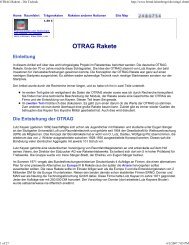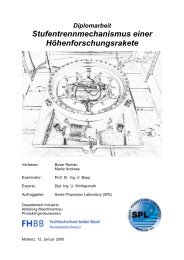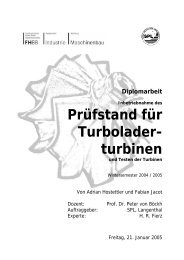Create successful ePaper yourself
Turn your PDF publications into a flip-book with our unique Google optimized e-Paper software.
ut it is quite another to launch a rocket, especially if one has so far been tested only<br />
single engines, and now 500 are fired at once. On the concept already existed in the 70's<br />
strong criticism. The DFVLR examined it and came to the conclusion that the financial<br />
success is questionable. With the technical approach is employed Prof. Ruppe. He came<br />
to the conclusion that to be too optimistic on the one hand the details of <strong>OTRAG</strong> and it is<br />
questionable whether it is technically feasible. Other experts complained numerous<br />
"white spots" in the concept, that is completely unresolved aspects of the support. Here<br />
are some personal considerations which must be assessed critically in this rocket.<br />
POGO effects<br />
Start No. 15 Photo 1The construction is very susceptible to POGO oscillations. POGO<br />
oscillations in rocket technology feared because they can not be simulated on the ground.<br />
Several rockets were suffering from the first flights under POGO oscillations, the Titan,<br />
Saturn V and the Ariane. Is caused by engine vibrations which are transferred to the tanks<br />
and bring the liquid to spill. This then amplifies the vibrations again so that it may in<br />
extreme cases to a fraction of the structure, as it happened in the second flight of the<br />
Ariane first<br />
This affects almost only first steps because they have very long tanks. In addition, the<br />
phenomenon usually occurs only after some time when the tanks are no longer full.<br />
Looking at the <strong>OTRAG</strong> rocket, so the tanks have a length of up to 24 m and a width of<br />
only 0.27 m. Representing a ratio of 80:1 means of length to width. In contrast, rocket<br />
stages, it is from 4:1 to 8:1. Furthermore, the tanks are already at the start only partially<br />
filled with fuel. Speaks against a vulnerable print promotion. There is no turbo pumps<br />
and portable engines, which come as sources of vibration in question.<br />
All tests which has made the <strong>OTRAG</strong> were relatively short modules (6 or 12 m length)<br />
instead. The shorter due to their length do not react quite as sensitive. It should also take<br />
into account that the tanks are very thin and, therefore, a break is easier. Kayser himself<br />
admits that the construction of long steps (18, 24 m) is only possible by pooling of many<br />
engines. Even without POGO oscillations otherwise the construction is not stiff enough.<br />
On the other hand, the rocket built entirely differently than other types and is constantly<br />
expanding the more modules are available. This can have an impact. It will probably be<br />
in the <strong>OTRAG</strong> rocket as with other missiles: for the first show for how the rocket<br />
behaves.<br />
The N-1 effect<br />
Start No. 15 2It image is a mistake to believe an engine, which we have extensively<br />
tested on the ground would be flight-qualified so automatically. The European space<br />
exploration has bitterly during initial launch of the Ariane 5 ECA experienced, not as the<br />
Vulcain 2 engine in flight withstand the pressures, although it was extensively tested on<br />
the ground before.<br />
Another improvement is the bundling of engines. Each engine also indirectly affects the















